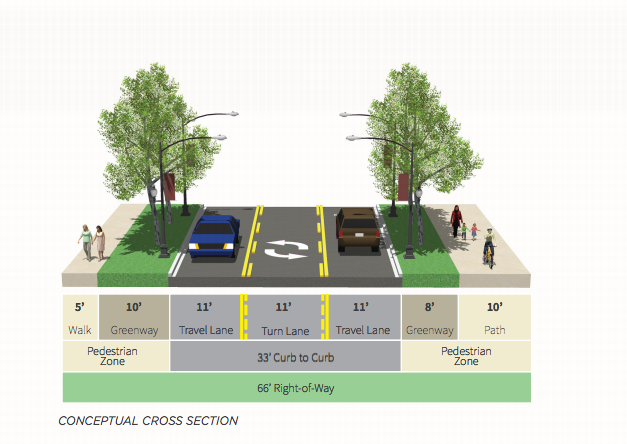Felker: Is the Lincoln Way ‘road diet’ a mistake in the making?
lincoln way
April 17, 2017
As all things on this good Earth are eventually ground to dust and forgotten to time, so too might be Lincoln Way (in its present form), if the Ames City Council is to have its way. And though I am in constant struggle with myself and my pen to stop its becoming a stick-in-the-mud, I do think it’s beneficial to here play the devil’s advocate. Consulting firm Houseal and Lavigne’s proposed “road diet” might just be a mistake in the making.
This road diet, part of a larger Lincoln Way “Corridor Plan” prepared by the consulting firm and adopted as an “advisory document” by the Ames City Council this past Tuesday, calls for the reconfiguration of parts of Lincoln Way to a two-way street (with a center turning lane).
Specifically, from the bridge spanning Squaw Creek to (roughly) the intersection of Lincoln Way and Duff Avenue. This is by far some of Ames’ most trafficked roadway, receiving as much as 15,000 travelers in annual average daily traffic flow.
Traditionally, the benefits of a road diet — or roadway configuration, as the Federal Highway Administration (FHWA) calls it — “include a crash reduction of 19 to 47 percent, reduced vehicle speed differential, improved mobility and access by all road users, and integration of the roadway into surrounding uses that results in an enhanced quality of life.”
Generally a relatively low-cost improvement, the FHWA explains that “a key feature of a Road Diet is that it allows reclaimed space to be allocated for other uses, such as turn lanes, bus lanes, pedestrian refuge islands, bike lanes, sidewalks, bus shelters, parking or landscaping.”
The lanes themselves, in this case, will be marginally narrowed by 1 foot, and the space for pedestrians and landscaping will be doubled (see diagram).
On the surface, this seems like perhaps a decent idea. This stretch of Lincoln Way (and almost the whole thing in its entirety) is notoriously unnavigable for cyclists or pedestrians. Any way this might be improved is an idea at least worth hearing and considering. To add, if the diet is as capable as it claims in actually improving traffic flow, then I am all ears; it takes significantly longer than it should to drive from one side of Ames to the other.
But even so, I cannot help but think that a plan like this is trying to accomplish too much at once. I don’t believe that Ames needs a sweeping sort of corridor renovation like this plan calls for, and I am skeptical that a road diet implemented on this sort of scale would make matters any better than they currently are. Our city is a victim of sprawl, and the way to fix sprawl is bit-by-bit—not wholesale.
It is Lincoln Way’s unique nature that worries me most about this. This street serves as our primary east-to-west thoroughfare, is a prominent entrance and exit to the city and cuts past Campustown, campus itself and the lion’s share of the city proper — why should we be experimenting on such an integral vein?
What will come of basketball and football games, when tens of thousands of visitors will be streaming through Ames toward Hilton and Jack Trice? Or what about our city’s coveted CyRide? These buses will not only become slaves to the hour’s traffic but will themselves become roadblocks to other travelers. The routes that travel in between campus and the eastern Lincoln Way corridor are some of the students’ most used — will they still be dependable? Will they still be timely?
This Corridor Plan calls for quite a bit of development — only one part of it is this road diet. I am far less critical toward these other “low hanging fruit” — as city council members Tim Gartin and Bronwyn Beatty-Hansen describe — like landscaping and lighting improvements. My suggestion is to go ahead with these more low-risk projects, and hold off on the implementation of a road diet.
While I can see Lincoln Way as a two-lane road in the distant, misty future, to transform it so dramatically, so quickly, might just be imprudent. I would recommend a more plodding, careful pace to truly renovate Lincoln Way into the “backbone” that ties Ames together, per Houseal and Lavigne’s wishes, and to even slowly incorporate this space between University Boulevard and Duff Avenue into an extension of the downtown Ames area.







